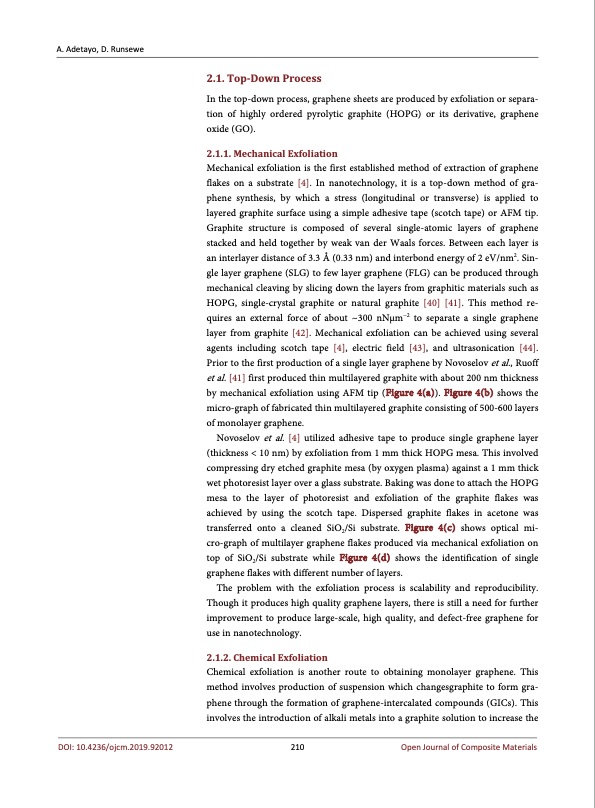
PDF Publication Title:
Text from PDF Page: 004
A. Adetayo, D. Runsewe 2.1. Top-Down Process In the top-down process, graphene sheets are produced by exfoliation or separa- tion of highly ordered pyrolytic graphite (HOPG) or its derivative, graphene oxide (GO). 2.1.1. Mechanical Exfoliation Mechanical exfoliation is the first established method of extraction of graphene flakes on a substrate [4]. In nanotechnology, it is a top-down method of gra- phene synthesis, by which a stress (longitudinal or transverse) is applied to layered graphite surface using a simple adhesive tape (scotch tape) or AFM tip. Graphite structure is composed of several single-atomic layers of graphene stacked and held together by weak van der Waals forces. Between each layer is an interlayer distance of 3.3 Å (0.33 nm) and interbond energy of 2 eV/nm2. Sin- gle layer graphene (SLG) to few layer graphene (FLG) can be produced through mechanical cleaving by slicing down the layers from graphitic materials such as HOPG, single-crystal graphite or natural graphite [40] [41]. This method re- quires an external force of about ~300 nNμm−2 to separate a single graphene layer from graphite [42]. Mechanical exfoliation can be achieved using several agents including scotch tape [4], electric field [43], and ultrasonication [44]. Prior to the first production of a single layer graphene by Novoselov et al., Ruoff et al. [41] first produced thin multilayered graphite with about 200 nm thickness by mechanical exfoliation using AFM tip (Figure 4(a)). Figure 4(b) shows the micro-graph of fabricated thin multilayered graphite consisting of 500-600 layers of monolayer graphene. Novoselov et al. [4] utilized adhesive tape to produce single graphene layer (thickness < 10 nm) by exfoliation from 1 mm thick HOPG mesa. This involved compressing dry etched graphite mesa (by oxygen plasma) against a 1 mm thick wet photoresist layer over a glass substrate. Baking was done to attach the HOPG mesa to the layer of photoresist and exfoliation of the graphite flakes was achieved by using the scotch tape. Dispersed graphite flakes in acetone was transferred onto a cleaned SiO2/Si substrate. Figure 4(c) shows optical mi- cro-graph of multilayer graphene flakes produced via mechanical exfoliation on top of SiO2/Si substrate while Figure 4(d) shows the identification of single graphene flakes with different number of layers. The problem with the exfoliation process is scalability and reproducibility. Though it produces high quality graphene layers, there is still a need for further improvement to produce large-scale, high quality, and defect-free graphene for use in nanotechnology. 2.1.2. Chemical Exfoliation Chemical exfoliation is another route to obtaining monolayer graphene. This method involves production of suspension which changesgraphite to form gra- phene through the formation of graphene-intercalated compounds (GICs). This involves the introduction of alkali metals into a graphite solution to increase the DOI: 10.4236/ojcm.2019.92012 210 Open Journal of Composite MaterialsPDF Image | Synthesis and Fabrication of Graphene and Graphene Oxide

PDF Search Title:
Synthesis and Fabrication of Graphene and Graphene OxideOriginal File Name Searched:
OJCM-2019042814574897.pdfDIY PDF Search: Google It | Yahoo | Bing
Salgenx Redox Flow Battery Technology: Power up your energy storage game with Salgenx Salt Water Battery. With its advanced technology, the flow battery provides reliable, scalable, and sustainable energy storage for utility-scale projects. Upgrade to a Salgenx flow battery today and take control of your energy future.
| CONTACT TEL: 608-238-6001 Email: greg@infinityturbine.com | RSS | AMP |